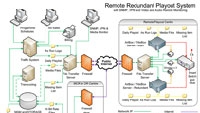Managing remote playout using public Internet II
In Part 2 of this two-part feature, Don Ash of PlayBox Technology describes a project he carried out with FOX International that enables broadcasters to reach new markets with a cost-cutting product dubbed the FoxBox.
Remote playout system

The heart of the playout system is two AirBox servers with triple redundant PSUs. The outputs are connected to a Smart Switch that monitors each output, and if the main server should fail in either video or audio and the redundant server is available, it will switch to this server.
The Smart Switch has dual redundant power supplies. In addition to the Smart Switch, there is relay bypass to allow switching of the main server output to the transmitter path in case of a power failure. The relay bypass can also be switched remotely if there is a signal path failure.
Remote monitoring
Remote monitoring is vitally important, especially where the channel output cannot be viewed from the control center. Monitoring of the AirBox, TitleBox, Smart Switch and the server hardware is done by SNMP, which sends alarms if anything should happen. All the remote servers are also connected to VPN and can be accessed remotely from anywhere in the world, according to rules defined in the firewall.
For remote audio and video monitoring, there are three SlingBox units that are connected to the output of each server, and the main output of the Smart Switch this will enable the broadcast or support center to see any problems remotely.
The professional video industry's #1 source for news, trends and product and tech information. Sign up below.
Local monitoring and control
At the remote location, there is optionally equipment for local control and monitoring in case of a catastrophic failure. There is a 2RU video and audio monitor unit that can be switched between the main/redundant playout servers and the main output of the Smart Switch as well as a KVM switch attached to a 1RU keyboard, monitor and mouse. This monitoring is also useful during installation and setup of the systems and any future on-site maintenance visits
File transfer servers and agents
The content owner’s broadcast center is connected to each remote location via a file transfer server and a firewall at each end, which can include a file transfer system agent to speed up file transfer times, include multiple Internet paths and check file validity.
Local commercials, content and QC
Local commercials and locally produced content can be ingested locally and sent to the broadcast center. Where only commercials are involved, they can be sent in high-res format to the broadcast center for quality control and stored on the MAM for the usual process of transcoding and transfer to the remote playout systems.
Where a small amount of local content is required, this can be treated in the same way as commercials. Where more content is required, it can be transcoded locally into the playout file format for the channel and sent to the broadcast center for QC before being sent to the MAM system for transfer to the remote playout system
This means that the content will actually travel back and forth to the remote playout location, but this is the best solution to enable QC with the highest reliability.
Remote media format
The media format used at the remote location can be decided by considering a number of factors, such as the amount of new media per day, the bit rate chosen for playout and the available Internet capacity. MPEG-2 IBP at 10Mb/s is often chosen; however, H.264 at 4Mb/s or less is also chosen as an acceptable alternative.
Remote and local support
Each PlayBox module has a PlayBox Doctor that is a very powerful aid to finding most problems remotely. As these systems are installed in remote locations and connected to the Internet, PlayBox Technology can, with authorization, log on remotely, find and resolve the problem quickly.
